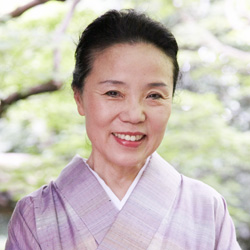Plants (colour) animals ( thread ) and minerals ( mordent ) are not only materials but also providers of life forms.
In response to that, we make things using intelligence and sensibility. Not making beautiful things but the things which we make in this kind of process by putting in our souls learn how to become beautiful. If we go off the path, no beauty will come.
Born in Shiga prefecture.
Dyeing and weaving Artist, Essayist.
At the age 31, under the instruction of her mother, she began weaving with pongee yarn dyed with plants’ dye.
Holder of Important intangible cultural heritage ( Living National Treasure ), Cultural Contributor.
Books: ‘One colour, One life’ ( Jiro Osaragi award ) ‘Mother Colour’
Portfolios: ‘Weaving and Writing’ , ‘Bonfire’
Limited Edition: ‘Fabric Book’ , Textbook of Ars Shimura, ‘The Book of Shimura’s tradition colours’
‘The Shimura colours’ coauthored with Yoko Shimura

Dyeing and weaving largely depends on its relationship with threads.
We dye threads and warp the threads. Then before we put the treads on a loom, we wring, bundle, stretch and loop them. Finally we weave the threads. Afterwards, threads get tangled or cut, but if you put them back in order patiently, you will see the light on the other end and you will know which direction to follow.
The process in which threads become textile is somehow similar to the process of human lives.
Born in Tokyo.
Dyeing and weaving artist.
She was strongly fascinated by ‘ Aidate ‘ ( The process of making indigo dye ) and in her 30’s, she started her dyeing and weaving career like her mother, Fukumi Shimura.
In 1989, she established ‘Tsuki Atelier’ as a place for people to learn weaving comprehensively through religion, art, educations and all other aspects in culture.
Portfolio: ‘Design of dyeing and weaving Opera’ by Yoko Shimura
